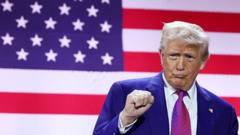In a bid to recalibrate trade relations with Canada, U.S. President Donald Trump momentarily stepped back from his plans to impose hefty tariffs on Canadian steel and aluminum imports. This decision came after a period of escalating tensions and threats—including a proposal for 50 percent tariffs. The announcement of the planned levies followed Ontario's implementation of an additional charge on electricity exports to the U.S., which Trump attributed to retaliatory measures against earlier tariffs he had imposed. However, by the afternoon, Ontario leader announced the suspension of the electricity surcharge, prompting Trump to imply a likely decrease in the newly proposed tariffs on Canadian metal imports.
**Trump Rescinds Threat to Heighten Tariffs on Canadian Metals Amid Ontario Concessions**

**Trump Rescinds Threat to Heighten Tariffs on Canadian Metals Amid Ontario Concessions**
President's tariff plans halted as Ontario suspends electricity surcharge, showcasing the complexities of trade dynamics between the U.S. and Canada.
In response to the rapid developments, a White House spokesperson highlighted that Trump's strategic pressure had compelled Canada to soften its stance. Consequently, the metal tariffs initially set to be doubled would align with those imposed on other global trading partners, remaining at a 25 percent rate, starting at midnight. This situation underscores the delicate balancing act of international trade agreements and the ramifications of tariff policies which can swiftly shift in response to regional actions and negotiations.
As trade dynamics continue to evolve, the situation exemplifies how quickly diplomatic relationships can shift and the implications for markets that rely on cross-border trade.
As trade dynamics continue to evolve, the situation exemplifies how quickly diplomatic relationships can shift and the implications for markets that rely on cross-border trade.





















